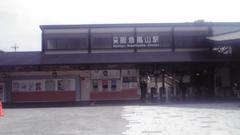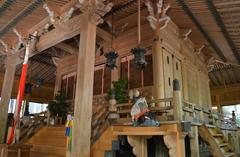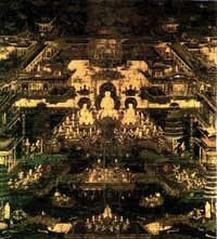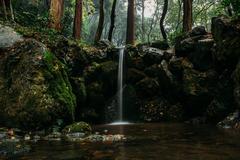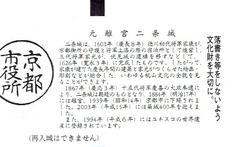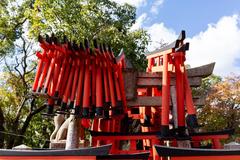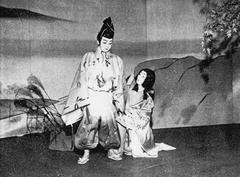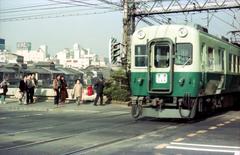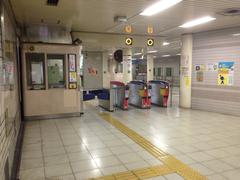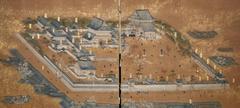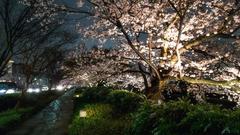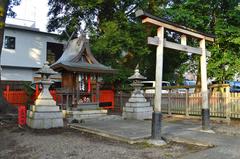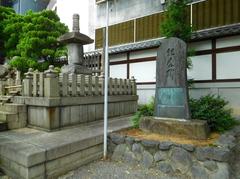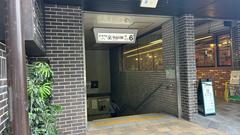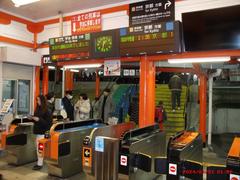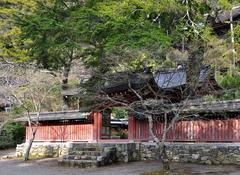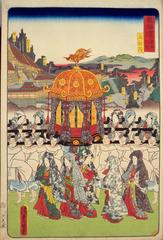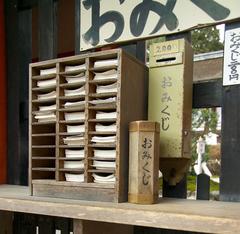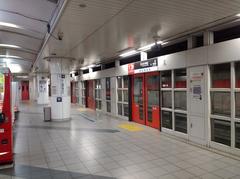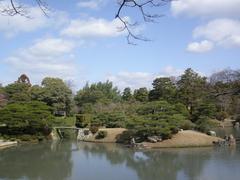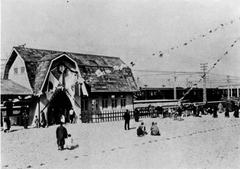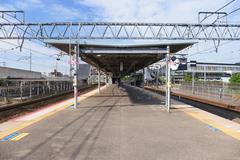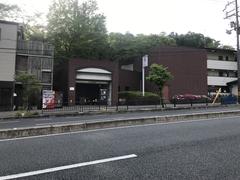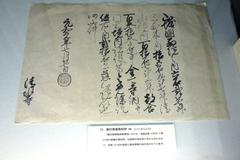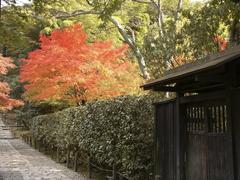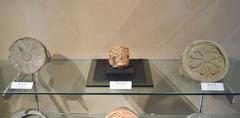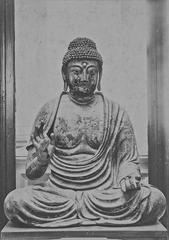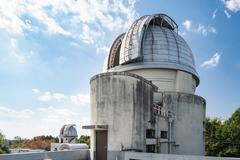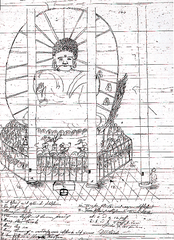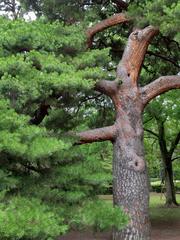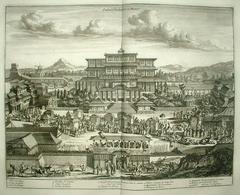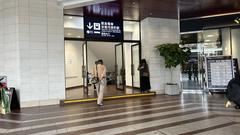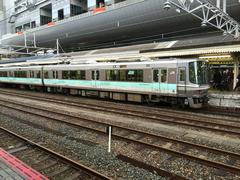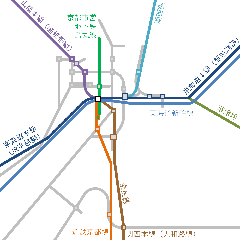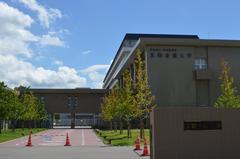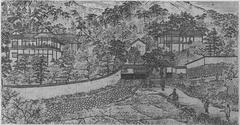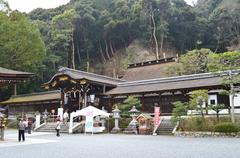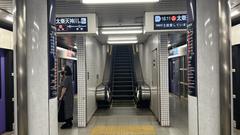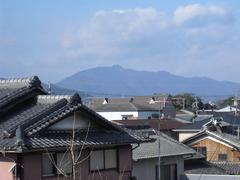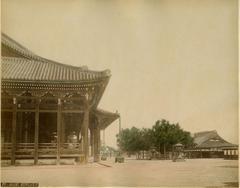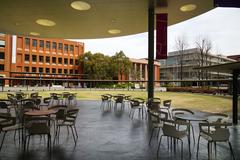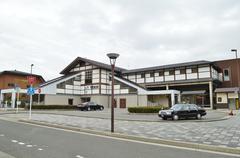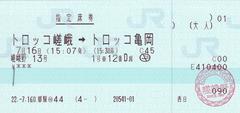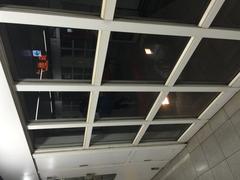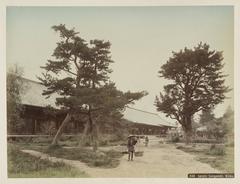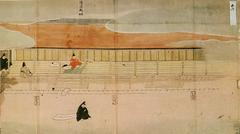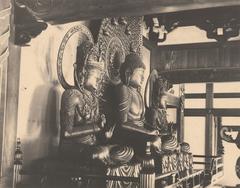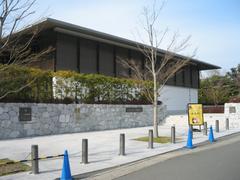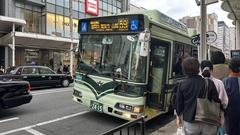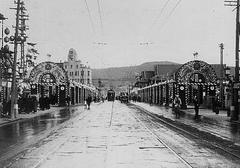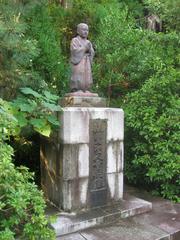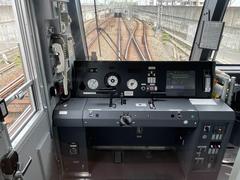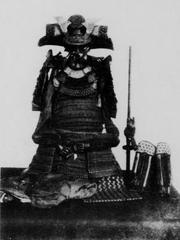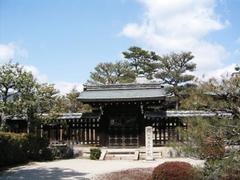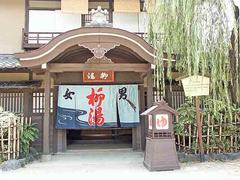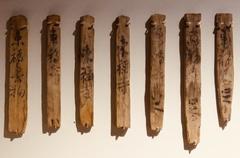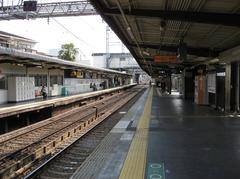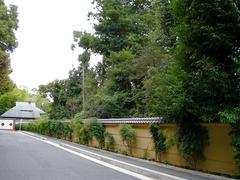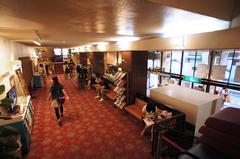
Kuramaguchi Station: Visiting Hours, Tickets, and Nearby Attractions in Kyoto
Date: 04/07/2025
Introduction to Kuramaguchi Station and Its Significance in Kyoto
Situated in the historic Rakuhoku district of northern Kyoto, Kuramaguchi Station is a vital gateway for travelers seeking to immerse themselves in the city’s rich blend of cultural, spiritual, and historical experiences. Since opening in 1981 on the Karasuma subway line, the station has provided modern transit convenience while reflecting the aesthetics and traditions of Japan’s ancient capital. Its strategic location offers seamless access to some of Kyoto’s most treasured temples, shrines, gardens, and cultural landmarks, many of which trace their origins back to the Heian and Muromachi periods (rahtours.com, ihtc-15.org).
Visitors disembarking at Kuramaguchi Station can easily reach iconic sites such as the Daitoku-ji Temple complex—a cornerstone of Zen Buddhism and the Japanese tea ceremony tradition—as well as the tranquil Kuramaguchi Temple, renowned for its seasonal beauty and meticulously maintained gardens (kuramaguchi-temple.jp). The station’s proximity to the Kyoto Imperial Palace, Nishijin Textile District, and the picturesque Kamo River further enriches the visitor experience, offering unique insights into Kyoto’s historical and cultural landscape (japan.travel, medium.com).
This detailed guide covers essential visitor information, including operating hours, ticketing, accessibility, and practical travel tips. It also highlights major seasonal events—such as the Gion Matsuri and Tanabata at Kifune Shrine—so you can plan your trip around Kyoto’s vibrant cultural calendar (magical-trip.com). Sustainable travel practices and community engagement initiatives are also featured to help you experience Kyoto’s treasures responsibly (tripjive.com).
Whether you’re a history enthusiast, spiritual seeker, or curious traveler, Kuramaguchi Station provides a captivating launch point for discovering the timeless charm of Japan’s cultural heartland.
Contents Overview
- Introduction
- Historical Development of Kuramaguchi and Its Station
- Origins of the Kuramaguchi Area
- Establishment and Evolution of Kuramaguchi Station
- Visiting Kuramaguchi Station: Hours, Tickets, and Accessibility
- Cultural Significance of the Kuramaguchi Area
- Historic Temples and Shrines
- Rakuhoku District’s Cultural Landscape
- Festivals and Community Traditions
- Notable Sites and Experiences Near Kuramaguchi Station
- Practical Visitor Information
- Attractions Near Kuramaguchi Station
- Kyoto Gyoen National Garden and Kyoto Imperial Palace
- Daitoku-ji Temple Complex
- Kamo River and Kamigamo Shrine
- Kifune Shrine and Kibune Village
- Shokoku-ji Temple
- Kyoto Botanical Gardens
- Nishijin Textile Center
- Seasonal Events Accessible from Kuramaguchi Station
- Practical Tips for Exploring Near Kuramaguchi Station
- Kuramaguchi Temple Guide
- History and Cultural Significance
- Visiting Hours and Admission
- Guided Tours and Special Events
- Access and Visitor Facilities
- Photography and Respectful Visiting
- Nearby Attractions
- Kuramaguchi Station Visitor Guide: Sustainable Travel Tips
- Transportation Connections
- Sustainable Practices
- Waste Management and Cultural Etiquette
- Green Initiatives and Community Engagement
- Digital Resources and Safety
- Frequently Asked Questions (FAQ)
- Conclusion
- Call to Action
Historical Development of Kuramaguchi and Its Station
Origins of the Kuramaguchi Area
Kuramaguchi Station is located in Kyoto’s Rakuhoku district, an area valued since the Heian period (794–1185) for its natural beauty and spiritual significance. The area’s original grid was established during Kyoto’s time as Japan’s imperial capital, with thoroughfares such as Kuramaguchi-dori—after which the station is named (rahtours.com).
Historically, Rakuhoku served as a retreat for aristocrats and monks drawn to its cooler climate and tranquil ambiance. Over centuries, it flourished with temples, shrines, and gardens, many of which remain accessible today from Kuramaguchi Station (ihtc-15.org).
Establishment and Evolution of Kuramaguchi Station
Kuramaguchi Station opened in 1981 as part of the Karasuma subway line, aiming to modernize public transit while preserving Kyoto’s heritage. The station efficiently connects central Kyoto to northern and southern suburbs and is designed to blend contemporary functionality with traditional Kyoto aesthetics (rahtours.com).
Visiting Kuramaguchi Station: Hours, Tickets, and Accessibility
- Operating Hours: Approximately 5:30 AM to midnight daily. Refer to the official Kyoto City Subway website for precise times.
- Ticket Information: Tickets are available at station kiosks. IC cards like ICOCA and Suica can be used for seamless travel. Single-ride fares start at around 210 yen.
- Accessibility: The station is equipped with elevators, escalators, tactile paving, and accessible restrooms.
- Travel Tips: To avoid crowds, visit during early mornings or late afternoons. The Karasuma Line offers straightforward transfers to other subway and rail lines.
Cultural Significance of the Kuramaguchi Area
Historic Temples and Shrines
Kuramaguchi Station provides access to several noteworthy religious and cultural sites:
- Daitoku-ji Temple: A pivotal Zen Buddhist complex with sub-temples and gardens, integral to Kyoto’s tea culture (ihtc-15.org).
- Imamiya Shrine: Renowned for the Yasurai Festival and deep-rooted Shinto practices.
- Genko-an Temple: Famed for its unique “Window of Enlightenment” and peaceful surroundings.
Rakuhoku District’s Cultural Landscape
Rakuhoku has long been a center for artistic traditions such as the tea ceremony, calligraphy, and Zen arts. Traditional machiya townhouses, many now functioning as cafes or galleries, offer insights into the city’s architectural legacy (medium.com).
Festivals and Community Traditions
Community engagement in events like the Gion Matsuri, cherry blossom viewings, and autumn foliage celebrations sustains Kyoto’s intangible heritage, ensuring traditions are passed down even as the city evolves (rahtours.com, medium.com).
Notable Sites and Experiences Near Kuramaguchi Station
- Daitoku-ji Temple Complex: Explore sub-temples with unique gardens and seasonal displays.
- Nishijin Textile District: Discover Kyoto’s brocade weaving tradition through workshops and shops (medium.com).
- Culinary and Market Experiences: Sample Kyoto cuisine at historic markets and eateries (rahtours.com).
- Seasonal Outdoor Activities: Enjoy cherry blossoms in spring, vibrant autumn foliage, and walking trails in the northern mountains (ihtc-15.org).
Practical Visitor Information
- Guided Tours: Available from local operators, focusing on temples, textile workshops, and cultural experiences.
- Photography: Temple gardens, machiya streets, and seasonal flora offer excellent photo opportunities.
- Getting There: Kuramaguchi Station is on the Karasuma Line, with easy access from Kyoto Station and other key hubs.
Attractions Near Kuramaguchi Station
Kyoto Gyoen National Garden and Kyoto Imperial Palace
A short walk south, Kyoto Gyoen National Garden provides a tranquil escape, enveloping the Kyoto Imperial Palace. The palace grounds are open year-round and free to enter; guided English tours are available by reservation. The area is wheelchair accessible and especially beautiful in spring and autumn.
Daitoku-ji Temple Complex
Just northwest, Daitoku-ji Temple is one of Kyoto’s most important Zen complexes. Several sub-temples charge a modest admission and feature classic Zen gardens. Tea gatherings and special openings are offered seasonally.
Kamo River and Kamigamo Shrine
The scenic Kamo River is ideal for walking or cycling north to Kamigamo Shrine, a UNESCO World Heritage Site. The annual Aoi Matsuri parade is a seasonal highlight.
Kifune Shrine and Kibune Village
Accessible via the Eizan Electric Railway, Kifune Shrine is nestled in the mountains, renowned for Tanabata celebrations and atmospheric autumn lantern displays.
Shokoku-ji Temple
Located just south, Shokoku-ji is a historic Zen temple with impressive seasonal events and accessible grounds.
Kyoto Botanical Gardens
A 15-minute walk north, the Kyoto Botanical Gardens showcase over 12,000 plant species and are fully wheelchair accessible.
Nishijin Textile Center
To the west, the Nishijin Textile Center features weaving demonstrations and kimono experiences.
Seasonal Events Accessible from Kuramaguchi Station
- Gion Festival (Gion Matsuri): July’s famed festival, accessible by subway (magical-trip.com).
- Tanabata at Kifune Shrine: Early July sees the shrine illuminated for the romantic Star Festival.
- Mitarashi Festival at Shimogamo Shrine: Participate in unique purification rituals.
- Kyoto Botanical Gardens Flower Festivals: Enjoy seasonal blooms and guided tours.
- Umekoji Handicrafts Market & Tōji Temple Flea Market: Monthly artisan and antique fairs (japancheapo.com).
- Kifune Shrine Water Festival: July’s celebration of the water deity.
- Fireworks and Summer Illuminations: Various temple light-ups and small fireworks events.
- Cultural Walking Tours: Join tea ceremonies, Zen meditation, or Nishijin weaving walks.
Practical Tips for Exploring Near Kuramaguchi Station
- Transportation: The Karasuma Line connects directly to Kyoto Station; buses and taxis are available for farther destinations.
- Visiting Hours & Tickets: Most attractions operate from 9:00 AM to 5:00 PM. Entry fees range from free to about 500 yen.
- Accessibility: Many sites are wheelchair accessible; some temple grounds have gravel or steps.
- Weather: July is hot and humid; dress accordingly and stay hydrated.
- Crowds: Major festivals can be crowded—arrive early and consider guided tours.
- Language: English is common at major sites; translation apps or guides are useful at smaller venues.
Kuramaguchi Temple Visitor Guide
History and Cultural Significance
Kuramaguchi Temple dates back to the Muromachi period, celebrated for its architecture and gardens reflecting Zen Buddhist philosophies. The temple has been a center for meditation and seasonal beauty, especially during cherry blossom and autumn foliage periods.
Visiting Hours and Admission
- Hours: Open daily from 9:00 AM to 5:00 PM (last admission at 4:30 PM).
- Closed: January 1 and select maintenance days (see official website).
- Admission: 500 yen for adults, 250 yen for children under 12. Group discounts for 10+ people.
- Tickets: Available at the entrance or online. Advance purchase is advised during peak seasons.
Guided Tours and Special Events
English and Japanese tours (approx. 60 minutes) can be booked in advance. The temple hosts tea ceremonies, calligraphy workshops, and seasonal festivals. Check the temple’s website for schedules.
Access and Visitor Facilities
- By Subway: Kuramaguchi Station (Karasuma Line, K05), about 10 minutes on foot.
- By Bus: “Senbon Kuramaguchi” bus stop is nearby.
- By Taxi/Walking: Taxis are widely available. Walking offers a chance to enjoy the local atmosphere.
- Facilities: Accessible restrooms, coin lockers, and a multilingual information center are provided.
Photography and Respectful Visiting
Photography is generally permitted outdoors; prohibited inside main halls. Visitors are asked to maintain quiet and respect the sacred environment.
Nearby Attractions
- Shokoku-ji Temple (5-minute walk)
- Teramachi Dori (historic shopping street)
- Kamigoryo-jinja Shrine (tranquil local shrine)
Kuramaguchi Station Visitor Guide: Sustainable Travel Tips
Transportation Connections
- Bicycles: Bike rentals are available, making local exploration eco-friendly.
- Public Buses: Electric and hybrid buses serve the area. Real-time schedules can be checked via the Navitime route planner.
- IC Cards: Rechargeable IC cards like ICOCA and Suica are accepted across subway and bus networks.
Sustainable Practices
- Eco-Friendly Sightseeing: Walking and cycling tours are widely available.
- Support Local: Choose cafes, shops, and accommodations prioritizing sustainability.
- Waste Management: Kyoto enforces strict waste separation. Carry reusable bottles and bags; public bins are scarce.
Cultural Etiquette and Community Engagement
- Respectful Behavior: Maintain quiet in temples, follow signage, and seek permission for photography.
- Support Preservation: Participate in community clean-ups and respect local customs.
- Seasonal Travel: Visit during off-peak hours or seasons for a more mindful and less crowded experience.
Digital Resources and Safety
- Transit Info: Use the Navitime route planner.
- Emergency Preparedness: Kyoto is safe, but note emergency exits and follow staff instructions during emergencies.
Frequently Asked Questions (FAQ)
Q: What are Kuramaguchi Station’s opening hours?
A: Daily from approximately 5:30 AM to midnight.
Q: How do I buy tickets?
A: At vending machines or with IC cards like ICOCA and Suica.
Q: Which historical sites are nearby?
A: Daitoku-ji Temple, Imamiya Shrine, Genko-an Temple, and more.
Q: Is the station accessible?
A: Yes, with elevators, escalators, tactile paths, and accessible restrooms.
Q: Are guided tours available?
A: Yes, many local operators and temples offer guided tours, some in English.
Conclusion
Kuramaguchi Station is much more than a transport hub—it is your portal to the living history, culture, and traditional artistry of Kyoto. From serene temples and vibrant festivals to sustainable travel options and immersive experiences, this area offers something for every traveler. Plan ahead, travel responsibly, and savor the unique charm of Kyoto’s Rakuhoku district.
Call to Action
Ready to explore Kyoto? Download the Audiala app for up-to-date travel tips, guided audio tours, and exclusive itineraries centered around Kuramaguchi Station and beyond. Stay connected with us on social media for the latest event updates and curated Kyoto guides.
Sources and Further Reading
- Kuramaguchi Station and Kyoto Historical Sites: Visiting Hours, Tickets, and Cultural Guide, 2025, rahtours.com
- Kuramaguchi Temple: Visiting Hours, Tickets, History, and Visitor Guide, 2025, kuramaguchi-temple.jp
- Attractions Near Kuramaguchi Station: Visiting Hours, Tickets, and Kyoto Historical Sites Guide, 2025, japan.travel
- Kyoto’s Historic Preservation: Machiya and Beyond, 2025, medium.com
- Kyoto Events and Festivals 2025, 2025, magical-trip.com
- Sustainable Kyoto Travel Guide, 2025, tripjive.com
- Kyoto Municipal Subway and Transit Planner, 2025, navitime.co.jp
- International Heritage Tourism Council: Kyoto Guidebook, 2025, ihtc-15.org











